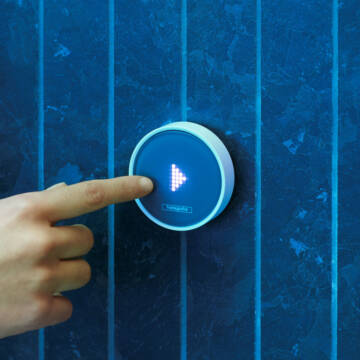What is IoT?

The Internet of Things (IoT) refers to physical devices which are connected to the internet to send and receive data and instructions. The popularity of the so-called IoT-devices is increasing every year, with more than 30 billion connected devices expected by 2023.
The Internet of Things (IoT) refers to physical devices which are connected to the internet to send and receive data and instructions. The popularity of the so-called IoT-devices is increasing every year, with more than 30 billion connected devices expected by 2023.
The Internet of Things (IoT) refers to physical devices which are connected to the internet to send and receive data and instructions. The popularity of the so-called IoT-devices is increasing every year, with more than 30 billion connected devices expected by 2023. In this article we tell you everything you need to know about IoT, and we’ll take a look at the most prevalent IoT-applications.
New IoT-devices are continuously being developed for almost every industry: the medical sector, production industry, entertainment business, home appliances, automotive, … But, before we get into the different IoT-applications, let’s take a look at the meaning and origins of the Internet of Things.
What is IoT?
The Internet of Things is a network of interrelated, interconnected objects that are able to autonomously collect and transfer data over a wireless network. The ‘object’ can be referred to as an IoT-device, which is equipped with sensors and intelligence, hence the name ‘smart devices’. IoT-devices are everywhere: medical devices, household appliances, smart watches, connected cars, smartphones, smart lighting, smart security systems, connected machines in production facilities, …
What is a smart device?
Many smart devices that exist today are traditional devices to which intelligence has been added so that they can exchange data over the internet.
Basically, to be considered a smart device, an object must consist of different components:
- The physical component = mechanical + electronics
- Smart Component = uP, sensors, data storage, control system, software, OS = (artificial) intelligence, algorithms, logic ...
- A connectivity component = wireless, wired (can be 1-1, 1-M, M-M)
The capabilities of smart, connected products can be grouped into four areas: monitoring, control, optimization, and autonomy. Each builds on the preceding one; to have control capability, for example, a product must have monitoring capability.
How IoT started
The roots of IoT can be tracked down to a cola-vending machine at Carnegie Mellon University (CMU), back in 1970. Because of the high consumption rate of Coca-Cola bottles, students and staff regularly stood in front of an empty vending machine. As a solution, some members of the computer science department created microswitches for the machine to sense how many bottles where available. Using the self-developed software, people could ping the computer for information about the availability of bottles. Because CMU was part of ARPANET, other universities could access information about the vending machine at CMU.
It is considered as an early example of an IoT-device. Yet, the term ‘Internet of Things’ was only used for the first time by technology-expert Kevin Ashton in 1999. And still, it took several more years, with the adoption of RFID, Wi-Fi and 4G, before IoT emerged as a wide-spread technology.
IoT in industry
Industry has widely adopted IoT as a means to increase efficiency and boost productivity by automating manufacturing processes, monitoring performance and providing accurate real-time data. In industry, IoT is often mentioned in the same breath as ‘Industry 4.0’ and ‘Industrial Internet of Things’ (IIoT).
Industry 4.0 is characterized by 3 elements:
- Smart machines that are equipped with sensors and software for data tracking and data logging
- Robust computer systems to store and process data
- Data analytics systems that provide valuable information for process improvements
Companies looking for a competitive advantage need look no further than the opportunities offered by IoT. The benefits extend across all business domains, from manufacturing, maintenance and supplier logistics to employee safety and product delivery. With the convergence of various technologies such as AI, quantum computing, blockchain and 5G, IoT will come into its own. Bringing us to a ubiquitously connected intelligent world.
Valuable IoT-applications
Next to the Industrial Internet of Thing, there are many other IoT-applications that create value and efficiency in our daily lives.
- Smart cities: IoT can help to create smarter and more efficient cities in terms of energy, transportation, parking and more. Smart traffic light that can adapt to actual traffic conditions or be set remotely to give priority to emergency vehicles. Energy grids that can be optimized. And parking apps that sent real-time information about available parking spots to drivers looking for a place to park.
- Healthcare: With smart medical devices patients and doctors will meet less frequently in person. Remote health care will gradually become established. E.g. IoT can be used to monitor and reporting a person's heart rate, blood pressure, and other health markers. Sensors can be integrated in wearables such as smart socks or smart t-shirts. And it can offer general assistance and advice during physical training.
- Smart agriculture: Connected trackers can send the location of animals as they graze in open land. Smart irrigation systems with humidity sensors can create just the right amount of irrigation to reduce water consumption and optimize crop growth. Vintners use smart sensors to monitor the health and sugar levels of grapes.
- Supply chains: IoT is widely used to track and trace products across the supply chain, from the production line, over logistics, up to final delivery.
- Smart (and autonomous) vehicles: Car manufacturers are developing technologies and sensors for capturing information about road conditions and preventing potential accidents. In the future autonomous vehicles may drive our streets using IoT-technology.
Latest insights & stories

A Global Movement: The World Unites in a Pink Pledge for Clean and Sustainable Water
5,000 participants. 32 countries. €30,000 funds raised. And that's just the beginning.
Picture this: One step that sends ripples across the globe, transforming lives and creating waves of change. You might wonder, how can such a simple action for most of us have such a profound impact?

Sustainability and circularity in construction
Join us in transforming the future of construction, creating buildings that not only stand the test of time but also contribute to a healthier planet!

RainTunes: Shower scenarios for the soul
Light, hearing, smell, and touch: Together with experts, we have developed sensuous scenarios that turn showering into an individual experience. Whether you want to prepare for the day ahead or relax after working out. Whether you want to refresh after a day’s work or unwind at the end of the evening: RainTunes surprises with multisensory experiences.*
*Currently available only in Germany and Austria.